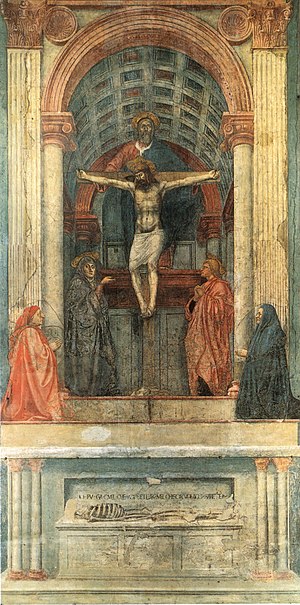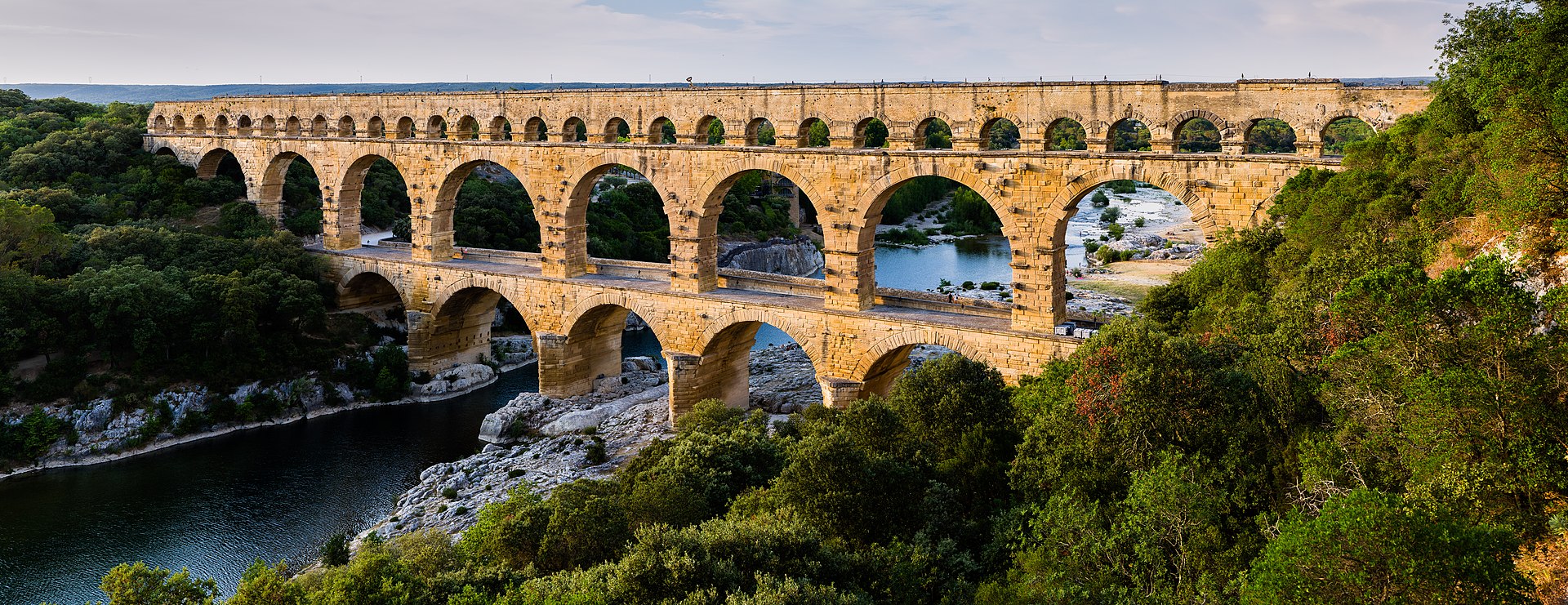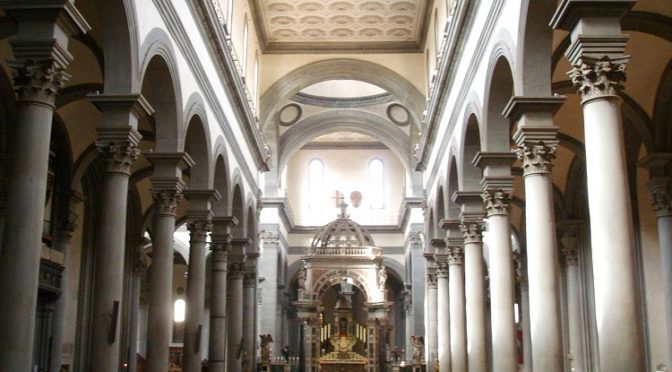Sundays are good for foundational reading. Here’s another journey to our not so distant past that should have prepared us to the future had we not gave in to the whims of the “authority”, i.e. the pseudo-illuminate priesthood who are forcing us to serve and sustain a system built with their false belief of knowing what’s best for humanity.
These people are still here, and are holding critical positions of power in our society.
It is the animals sheltering behind Vatican Church who want to subvert real scientific advancements for their own exclusive advantage.
Our job is to know more about them and to know more about what could have been possible if such regressive notions are suppressed at this very late hour.
What Brunelleschi Knew and How He Knew It
This transcript appears in the December 18, 2015 issue of Executive Intelligence Review.
[PDF version of this article]
This edited transcript of LaRouche PAC’s regular “New Paradigm” internet television show of April 9, 2014, now nearly two years old, complements the discussions of the role of Filippo Brunelleschi contained in EIR’s previous issue of Dec 11. It has never before appeared in EIR.
Megan Beets: Good afternoon, today is April 9th [2014]. My name is Megan Beets, and I am joined in the studio today by Mr. Lyndon LaRouche and Jason Ross, of the LaRouche PAC Scientific Research Team.
Now, just to set the context of today’s discussion, the world is currently suffering the effects of what has been an absolutely fatal breakdown crisis in political guts and political leadership in the United States: We have a fascist President installed in the White House, who is acting on behalf of a British Empire to drive the world to the brink of thermonuclear war, a war of extinction. Now, in the United States, three-quarters or more of the American people, no matter your so-called party affiliation, hate this guy, want him out—need him out for their survival.
Now, what is the so-called “opposition” party, the Republican Party in the Congress, doing? What is their strategy? Well, rather than act to impeach this guy, and he is impeachable, their strategy is. . . “We’ll wait for the next election. We’ll wait until 2016, when we’ll install Jeb Bush” or something like that.”. . . .
Now, not only are we responsible for stopping the threat of thermonuclear war, but those of us who are willing to take leadership, such as yourself, Mr. LaRouche, are also leading the fight to ensure the basis for the continuation of civilization. And this is what we’re going to get into today: What is the basis for the operation of the human species in the universe? What is the basis for human progress, and progress of mankind on Earth, and beyond?

Who was Brunelleschi?
Jason Ross: All right. Yes, as we discussed last week and then three weeks ago on these triads, and just to reference a couple of other things for people to check out, besides those shows of March 19th and April 2nd, are also Mr. LaRouche’s two recent papers, “Is Satan Still Operating from Inside Bertrand Russell’s Corpse?” and “The Incompetence of Twentieth Century Science Education.”
So, today we are going to go into some more detail on the first triad, that of Brunelleschi, Cusa, and Kepler, in particular on Brunelleschi. Just to read a quote from you, Mr. LaRouche, from the show of March 19th:
“Okay, so let’s look at these two cases: All right, what did Brunelleschi prove? Brunelleschi proved the falseness of the straight line, of the existence of the straight line in the small. That was his great achievement. He extrapolated from the understanding that you can not use arbitrary predetermined lines in any way, to determine how processes work.”
And then a little later, you said:
“He came up with a whole new architecture, but more: He took the simple thing of a simple, hanging chain, the hanging chain model. . . . Then came Kepler as a follower, implicitly of Brunelleschi, and specifically of Cusa; he was very explicit about it. He solved the problem. So a third member of the triad came up with a solution! But Kepler’s solution depended upon both the implications of what Brunelleschi had done, which enabled Cusa to make his discovery. But the solution was not yet reached. The solution was done by Kepler.”
You added:
“So all competent modern science depends upon the reference to Kepler, in terms of Brunelleschi and Cusa. Anyone who eliminates any one of these three, Brunelleschi, Cusa, or Kepler, all as one group, is an incompetent in science, intrinsically.”
So, to make sure we are not incompetents in science, we’re today going to focus on Brunelleschi, about whom I was mostly unaware until rather recently, so we have some things to share about him.
Obviously, the most pronounced achievement of Brunelleschi is the dome of the Cathedral of Florence, the Cathedral of Santa Maria del Fiore. This is still today the largest masonry dome in existence on Earth, although it was built centuries ago. The cathedral was actually begun in 1296, which was when the first stone was laid, and some of the initial layout of the length of the church was designed. In part of the building boom of the Fourteenth Century of Florence, continued work was done, and then there was a debate, and actually a referendum, in 1367, to choose on the general design of the cathedral. The two choices were between the designs of one Neri di Fioravanti and Giovanni di Lapo Ghini.
The two designs differed in that Giovanni di Lapo Ghini proposed a Gothic style cathedral, one where,—unlike the dome as it looks today,—it doesn’t have the flying buttresses, which are the stone arches on the outside of the cathedral that help hold it inwards, that you see in the Gothic cathedrals; those buttresses allowed the walls to have many more windows that let in a lot of light, and that was why they were built. That was one of the two proposals. The other one, from Neri di Fioravanti, did not go with a lot of large windows as you can see, but got rid of all those buttresses, going for a simpler look, what he thought was a more “Florentine” look.
And the referendum was held and this is the design that won: Brunelleschi’s father had actually voted in the referendum, and he had voted for this design, so there’s a family connection to it. Part of the proposal from 1367 was for a dome of this sort to be built.
Now, nobody knew how to build that dome in 1367, but they still boldly decided that was the design they would pursue, and they would build up the rest of the cathedral and worry about how to build the dome later, which is what ended up happening. So the cathedral was being built; Brunelleschi was born in 1377. He lived a couple of blocks away from the cathedral, so as a young child, as a young man, he would have been familiar with the construction work that was taking place. Everyone in Florence knew this was going on, and he was right next to it.
So, Brunelleschi became apprentiDougDpiced as a goldsmith, which at the time was among the highest of the trades, because of the detailed work that was done, and because of the things that you could do as a goldsmith. Brunelleschi—we don’t have the actual model, but supposedly he even worked on building a clock that was powered by springs rather than weights, in his work as a goldsmith, which, if true, would have been the first spring-powered clock. It’s a little bit uncertain, as is much about his life.
His Early Breakthroughs
So the cathedral’s being built. The plan, to give a sense of the proportions, I’m not sure if you can see, but there are people standing at the very top, on the lantern, at the railing there, and you can see how tiny they are compared to the size of this dome. The peak of that cross above the gold ball at the top, is 375 feet in the air. So this is significantly taller than the U.S. Capitol—this is a tremendous building.


Figure 1
Depictions of the Sacrifice of Isaac, done for the competition to adorn the doors of the Baptistry next to Santa Maria del Fiore. On the left, the panel by Lorenzo Ghiberti; on the right, that by Brunelleschi.
So, back to Brunelleschi’s life: In 1401 or 1402, there’s a competition that he entered to design doors for the Baptistery of Florence, and he’s one of two finalists in this competition, along with Lorenzo Ghiberti. So, I would actually encourage everybody to look at these—it’s hard to see these in this video, I know; but if you take a closer look at them, you can compare the designs of Ghiberti on the left, and Brunelleschi on the right. (Figure 1), This was one sample panel of Abraham’s sacrifice of Isaac, before the angel stops him. Ghiberti won; Brunelleschi was not commissioned to build the doors, and he then set off on a trip to Rome. He went to Rome with his friend, Donatello, where he studied buildings, he studied construction, he studied art, to the extent that there were things to look at.
And in doing this, he developed the concept of perspective. So Brunelleschi really made a breakthrough in how vision works, and how perspective works, and made the breakthrough out of the flat paintings, that were seen, to the actually spatial ones.

FIGURE 2
Masaccio’s The Holy Trinity (Santa Trinità), a fresco in Santa Maria Novella in Florence.
This is a painting by his student Masaccio. (Figure 2) It’s called The Trinity and it’s in Florence. This was the first real perspective painting. And you can see, as you look at it, you’ve got Christ; you’ve got above him a dove, which is the Holy Spirit; and then you have God the Father behind him. And you can tell that there’s a sense of depth, you can tell by the way that ceiling is drawn behind him that it really appears that this goes back in space. And you can imagine when it was first painted,—and the paint wasn’t falling apart as it is now,—how realistic this must have looked, and what a shock it was to people to see a wall that looks as if it actually extends back.
Today, we might take this for granted, but it wasn’t always known. And this came from Brunelleschi. Leon Battista Alberti, who later wrote a book on painting, credited Brunelleschi as the inventor of perspective, which in this painting uses a vanishing point to create a real three-dimensional space, such that you can recreate the scene as a three-dimensional model, and you can place Christ and the Father,—you can actually place them spatially. This turns something flat into something spatial.
FIGURE 3
The Pantheon in Rome, completed in approximately 126 A.D. by the Emperor Hadrian.
So, among the things that Brunelleschi would have seen in Rome was the Pantheon. (Figure 3) Now the Pantheon, built by Emperor Hadrian—a Roman temple to all of the gods,—is almost exactly the same width as the Dome of the Cathedral in Florence. They’re basically the same width. The Pantheon, however, is a purely circular dome, whereas the one in Florence, as we saw, had ribs, and it’s in the shape of an octagon.
Now, even though this is the same width, it’s not as tall as Florence’s Cathedral, and if you look at it from the side, you can barely even tell that there’s a dome. In fact, it’s ugly from the outside; it’s hardly an inspiring sight. But this gave Brunelleschi an opportunity to look at how the construction occurred.
In the Pantheon, for example, the walls at the base of the dome are twenty-three feet thick: That’s how thick it had to be made to contain all of the stress, the architects thought. Also, when this dome was built, it was built by putting up a huge amount of scaffolding that actually filled up the entire space of the dome, upon which the concrete was then set, and then hardened, and then the wood was all removed.

FIGURE 4
The Roman aqueduct Pont du Gard, opened in 60 A.D. in the south of France.
This use of wood to set the shape is called “centering,” and let’s take a look at why that would be done. This is a Roman aqueduct; this is the Pont du Gard, today in France. (Figure 4) And so, if you want to make a structure that’s wider than the longest piece of stone that you can make, you have to put many pieces of stone together, and the arch is the shape that lets you span a distance. These arches were made with centering: If you just started building the blocks from the side, they’d of course just fall in. It’s only once you have the entire arch built and put in the keystone, that it then supports itself; before that it’s not stable, it doesn’t have an internal stability. And we’ll turn to what Brunelleschi did on this.

FIGURE 5
Arch-building in Morocco in September 2011 creative common/Haven La Chance
So this is a picture of some more modern—well, more contemporary—arch-building in Morocco, (Figure 5) and you can see there’s the centering, which is put underneath the arch: It sets the shape; you then lay the bricks. Once the mortar hardens, you can then remove the centering, and the arch maintains itself.

FIGURE 6
The Taq Kasra arch, located in Salman Pak, Iraq. It is estimated to have been erected in the now-disappeared city of Ctesiphon in approximately 540 A.D. Iranian Historical Photographic Gallery
Here’s another, very old, large arch: This is a vault in what is today Iraq. (Figure 6) This was built 1500 years ago in one of the Persian empires, and this is in the shape of an upside-down catenary. Catenary means “chain,” it comes from the word for chain: If you hang a chain—I meant to have one but I forgot—but if you have a chain or rope, and you let it hang, it’ll make a shape which is this, upside-down. It’s a very stable shape.
His Challenge to Stupidity
Let’s return to the Dome: The year is 1418, it’s August, and a competition is again being held in Florence. Brunelleschi has returned; this is 50 years after the 1367 referendum that decided on the overall shape. The Cathedral is built, and they’re ready to figure out how to start building the Dome. And just as in the doors of the Baptistery, again, the final two designers are Ghiberti and Brunelleschi. Brunelleschi, in proposing how to build this Dome, says he’s going to do it without any centering, he’s not going to use any scaffolding: He’s going to build this Dome, piece by piece, such that it’s stable as it’s being constructed, not only when it’s finished.
Nobody else thought this was possible. This really astonished people. The way the story goes, is that when people said, “how’re you going to build it? How’re you going to build it?,” he gave them a challenge: he said, “l’ll tell you how. To figure it out, you have to figure out how to make an egg stand stably on its end.”
Click page 2 to continue…




I must admit using described theory above , I would have believed article was attempting to ‘pull my chain’, that us until this morning, anyway. And to top that event, was finding this email among the myriadic bog of emails speckling my inbox that I hardly check as become reclusive in nature and socially acceptable to not many of human race but only to my 2 yorkies. With, that said, after the ah ha moment, I was actually quite humorous to myself, rarity, going as far as imagination was galactical, I was writing one liners in my mind & picturing myself as a comedian with minimally name recognition. I know that sounds either way out there past ridiculous but actually was/is presently transpiring as I recollect some of my sarcasm as I write this little diddy. Truly has been not only pleasant eye opening transcendence but way beyond my realm of belief but on tipping distant plateau of Extra Reality, to say the least. And, yes am scared but I cannot seen to have guidance over my wandering liberated mind surfing, catching myself dipping in & out of my known day’s activities only to catch myself laughing over my fresh experience from an unknown origin, at my corny thoughts that I only have. Truly Mind Blown Presently!! #biskit911